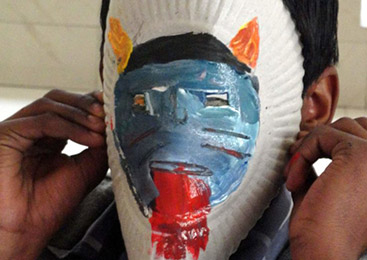
Volunteer’s Diary- Sahyog
Entering the gates of Sahyog campus triggered a series of emotions in me. Was it anxiety or fear or anger or compassion or curiosity? I don’t know! I entered the campus with an empty mind. I tried not to have any presumed notions about these juvenile offenders. The term ‘juvenile’ is used for person below the age of 18, accused in any crime. Having worked with children before, I believe these children were a little different. However, they were and they did behave like any other child of their age group would have.
Freud’s Psychoanalytic theory suggests that personality is mostly established by the age of five. Early experiences play a large role in personality development and continue to influence behaviour later in life. If these psychosexual stages are completed successfully, the result is a healthy personality. If certain issues are not resolved at the appropriate stage, fixation can occur. Perhaps, this issue makes them different from other children. Dysfunctional family, certain incidents, addiction, poverty, illiteracy, lack of guidance affects them.
Consequently, I was there to grasp and learn all I could, therefore I did not want to talk or do anything. I did not want to interrupt their activities. I just wanted to observe. Observe their actions, reactions.
I was amazed to learn how they had perceived of me as their ‘female’ volunteer, my clothes and my gestures. I was shot at with vulgar comments momentarily. They excelled at playing and twisting my words, so as to change its meaning completely. To their surprise, I was good at dodging them. With my presence, I was determined to bridge the gap. Their constant gaze at me confirmed the urgency of the same. We shook hands, talked, and laughed.
We started with the workshop, with over 30 boys. We worked on painting and decorating matchboxes.
I was happy to see the positive reaction towards the workshop. I took as a sign of acceptance. There were moments of vexation. However, my aim was to read into their minds, rather than sit back out of disappointment. Matchbox was just a medium. Whether they painted it or not, didn’t really matter. Small dusty hands, with chewed nails, scribbling black and white stripes, and then painted it all black, when almost a beautiful unpredictable design was going to come out. Some chose to keep quiet and observe, while some found it impossible to be quiet. I was amused to overhear a myriad of comments.
It was perhaps because of lack of interaction with the other sex. Their curiosity about the other sex is incomplete. Coming from dysfunctional families, the very idea of one’s mother, sister or a friend was still hazy. Most of them come from backgrounds where a casual friendly relation with the opposite sex is stigmatized. There was a tendency in them to emulate all ”film stars” and bollywood actors.
Bruise and cuts on their wrists and arms were enough for me to understand their extent of extreme feelings.
With my presence, I hope to abridge the gap between ‘us’ and ‘them’. They are disheartened and some have lost hope of coming back on track. I don’t want to be an idealist to them, but just wish to expose them to the normalcy of life, be it towards women, elders or law. Their expression in the form of art can be our path into their minds.
– Sanya is a Masters student who has been volunteering with us for a month. This is her feedback from her first session at SPYM Sahyog de addcition home.
READ MORE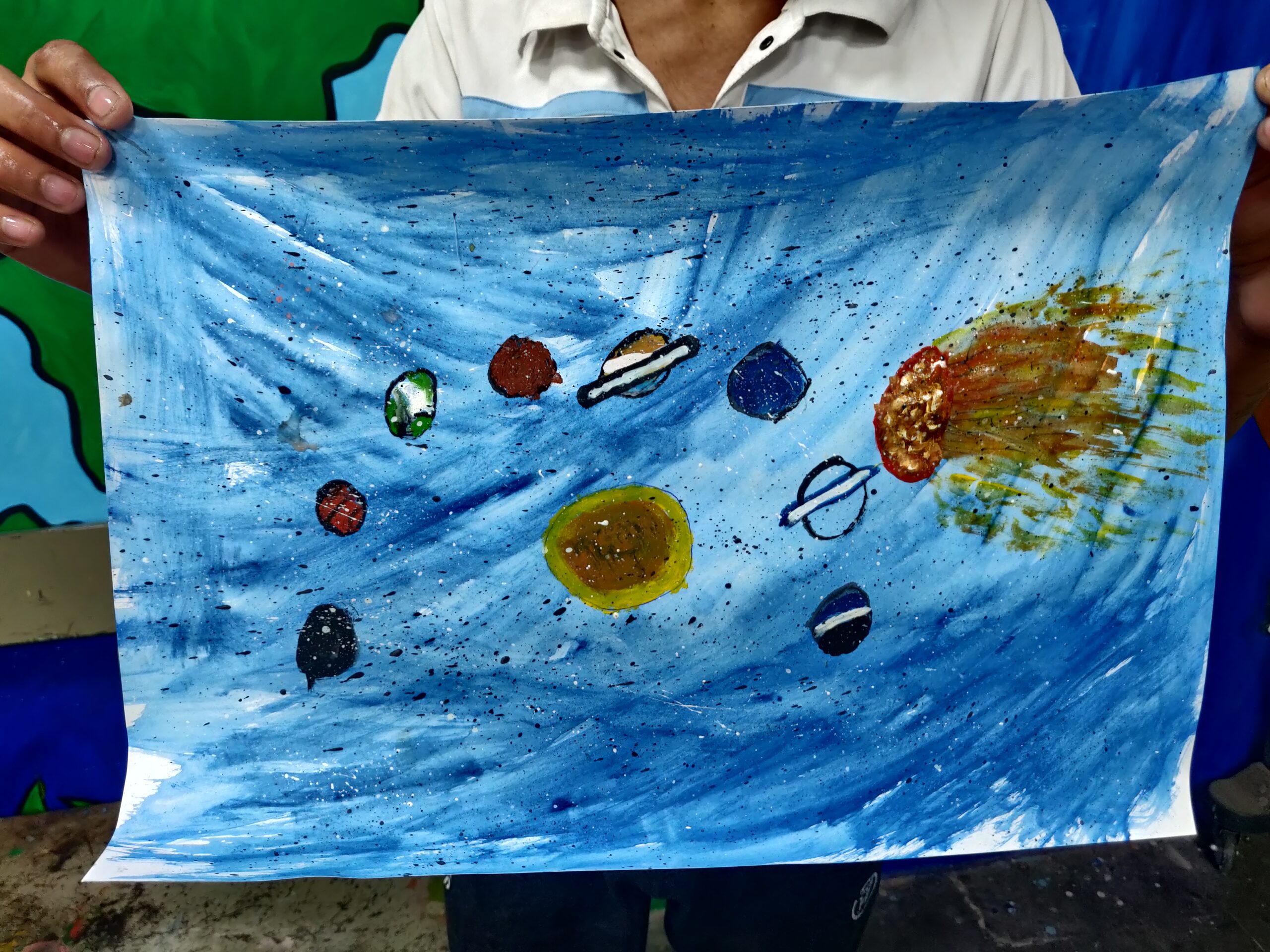
Colours of Hope!
The workshop that me and Poorva had thought of did not have a structure. It stemmed from a simple idea: no structure, just boys, paper, and the freedom to let the brush guide them. The world that the boys live in is already structured and bound by rigid rules. Adding more structure would just mimic their daily routine. Imagination is limitless but while talking to the volunteers at the home I realized that imagination can be limited if one is never allowed to explore and think beyond one’s boundaries.
While talking to Puneeta there was a discussion on people who come from outside for workshops can be a sign of hope for the boys. I do not know how I can be a sign of hope at times because I struggle in my daily life to find hope in terms of my future, but maybe because I do not have any literal constraints such as the bars that surround the boys but only the constraints in my mind. Maybe because I can see the sky without any physical/material constraints and can draw the Sonipat skies without having to emphasize the jail bars in my painting. Maybe because for me freedom is easy and taken for granted.
When we started to distribute brushes and paint there was a sense of confusion as the boys had to make their own choice in selecting the brushes like they didn’t know what and how to choose. When we began to paint few of them just sat down and looked at the empty canvas and other the room to search for an inspiration or idea. Some were skeptical to even pick up the brush and start using watercolors because it was new, and no colors appealed to them. Black dominated the palettes of five or six boys. It resonated with me. Why black? What darkness did they find in that shade? Did it grant them the courage to explore other colors, or perhaps express the darkness within them? There I was, surrounded by black, starting my own piece with vibrant reds, pinks, and greens. Paradoxical? Two realities coexist. But slowly, their paintings transitioned from darker shades to a lot of blue, sceneries, and smiley faces in inanimate objects.
I don’t know if the workshop will be fruitful in the long run, but I do hope that their imaginations will not be bounded by constraints of the society and boys will be shackled by the darkness of their past. Like any other teenager, I can only wish for them to find their happiness in the realm of their imaginations if not anything else.
– Eshani Bora, Young India Fellow, Ashoka University
READ MORE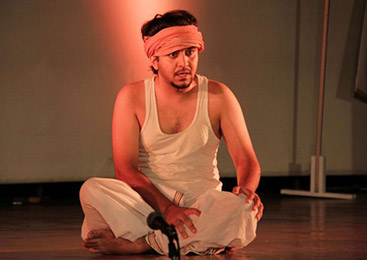
Sweet Reminiscence
What does it take to not forget something? Has it ever happened to you, that when you return from somewhere you have a difficult time adjusting at home? Withdrawal symptoms (as close as it could get) a plenty and you keep asking for more of the same experience. The only thing you think about for sometime is when, where and how you will get an opportunity to go back to the same place and experience something completely new? The true meaning of the term unforgettable is learnt. When you narrate stories of your journey, your mind leaves you gasping for more. Nostalgia, happiness, a weird feeling in the stomach, everything that makes you believe that this journey was special.
I don’t exactly remember when the process started and I certainly know it hasn’t ended. Once upon a time when we only thought we would be in Glasgow one day is now a time, existing, flowing, real and lived. We weren’t tourists (only), our intent was clear. That one hour in which we get to perform our play made the trip of ten days possible. ‘Shoonya se shikhar tak’ is therefore a landmark in my life. The intense training, workshops and preparations for this production has been growing experience. As an actor and as an individual, I have unmasked a lot within me. Shoonya se shikhar tak has not only made me realise the power of my dreams, but also my abilities to work on them. I can proudly say this intensity has made me lighter and stronger at the same time. The magical part is that i dont even know when this process started. It just seems smooth now that I look back on all these memories with fondness.
All of this however wasn’t limited to the one hour in the rotunda. But I think that this growth took a different course from there. Now that I think about it, I can’t find any words to describe my feelings the first time I stepped on the cushioned stage of the rotunda. The first time I ever tested my voice inside that dome, the first time I walked, crossed from one side to the other. Each movement of my body made me want to get that emotion more and more and made me never want to end this experience. And that one hour, when all our rehearsal time, our practise came to its actual test, the hour that made it all possible was an hour that I want to keep reliving. That one hour in which I was vulnerable, both emotionally and physically, on stage and especially off it is the hour I crave. As if that’s the kind of reality I want to keep living. Shoonya se shikhar tak has reached its first shikhar. I think it is time we take it forward, continue to work with ourselves and with this experience and make this journey limitless.
Its not so much about living a dream. It doesn’t hit you always that what you thought of once upon a time, is a reality you’re living. Its after you’re back, trying to adjust with your life that you realise that you just lived what you yearned for. I want to live it again. And keep living it.
For all this and more I would like to extend my heartfelt gratitude to everyone concerned and everyone who made this possible.
“Mere sapnon ka Yeh andaaz hai, ki har rang mein shaksiyat kuch khaas hai.
Mai kehta hoon Bohot ji li zindagi, Woh kehta ki abhi aur Jine ke aas hai.”
– Rijul Kataria works as a Research Coordinator with the Foundation. This blog was written as a part of the Tin Forest International Theatre Festival in 2014
READ MORE
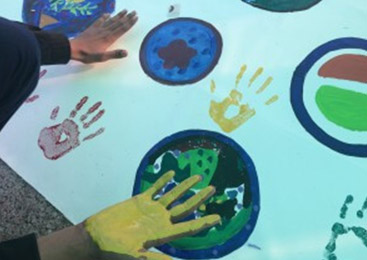
Small Wonder
I have, in my own small ways, since many years, dedicated a part of my so called ‘artistic abilities’ to be manifested in any kind of re-cycling and re-using objects of daily use. There is a wonderful joy in just painting an old envelope or a paper bag to make it re-usable or using it as a canvas, that I can’t explain! One such small wonder is creating your own pen out of newspaper!
When Subhadra approached me to facilitate one such workshop at DMRC Boys home, I was overjoyed… because I knew that it was a wonderful opportunity in skill building of the boys at DMRC. I have always believed in art, and joys of creating a product that is usable (and easy to do!) as well as a means of self expression thereby fulfilling the purpose of Art Therapy!
So there I was, overjoyed to see the turnout of around 20-25 boys all eagerly anticipating to make newspaper pens, something probably unimaginable, yet ‘Do It Yourself’ sort of a thing. The session was initiated with the meditation following which all the children received their sets of refills and sheets of newspaper. The boys were quick to learn and soon understood the procedure of rolling the pen to create the appropriate shape and then decorated them as per their own wishes. Needless to say, the tehelka interns were there alongside to help manage and guide the group of boys. The boys made some wonderful vibrant pens using paints and glitter. Well, I am sure the one who writes with them is going to cherish and who knows may even get ‘inspiration’ from The Pen itself!
It was great to see the overwhelming response by the kids who wanted to make more pens even after completing theirs. This was just another attempt to have fun with ourselves and to self-absorb in some of the simplest things in life! I am hopeful that such art workshops continue taking place at tehelka as it definitely helps the children hone their skills, keeps them focused and engaged, and allows them to learn something new as well as explore their creativity…
I thank the Yuva Ekta foundation team for gifting me a lovely fun-filled evening with the kids and I hope to come back again with such art attacks!
– Bani Malhotra is pursuing Masters in Art Therapy from Washington, D.C seeking to bring together, the disciplines of art and psychology to use art therapeutically. she has a background in theatre and works with up-cycling to make diaries, newspaper pens, bags and wrapping papers etc and has been associated with the Foundation since her school days.
READ MORE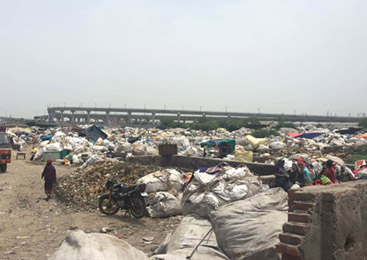
Interns Diary, An Hour in Jahangirpuri
On Thursday last week (July 21, 2016), I had the honour of receiving a personal tour of the notoriously infamous Jahangirpuri. It was built in the 1970s as a resettlement colony for the countless immigrants that had swarmed into the capital city in search for jobs and a better life. However, the unfortunate truth was that the capital could seldom offer many of them even a roof over their head.
Today, this colony, which was built with the aim of providing these people with a better, sheltered life has turned into a place infested with serious drug, crime and waste management problems.
The most obvious instance of the trash problem is the huge waste dump that exists behind the colony. The backyard of the colony is a massive space filled with garbage from all around the city, and while it has some serious health and hygiene implications, it is one of the ways in which many of the people in Jahangirpuri make a living. There are a lot of of recycling units around the colony, which employ young boys to search through the waste dump and gather recyclables such as thermocol, plastic or paper. This is not only good for the environment but also for the society as it promotes societal awareness and monetary support for many of the families living there who do not really have better alternatives for their basic income.
However, the boys that work in this field, colloquially known as the “kabaddiwaalas” are infamous for their bad behaviours, notably drug addiction, as they tend to spend the little money they earn on drugs or get easily involved in the gang trade. Moreover, working in such unhygienic conditions is hazardous to their health as they could attain all sorts of diseases from the constant exposure to waste and garbage, as well as get physically harmed in the process. For example, it is very common for them to get cut by broken shards of glass.
The other issue with garbage and waste in this part of town is the sewage system. The sewage canals are not covered and so there are obvious issues with this such as the flooding of this nasty water in the rainy season. Moreover, the potent smell doesn’t help the case. However, what shocked me more was that the sewage pumping station in the area would pump the sewage and dump the junk they pumped onto the banks of the sewage canals, which meant that the streets would be covered in this nasty-smelling, unhygienic sewage disposal, with no means of any sort of cleaning process. Their job was to pump it out, and so they would do just that, and leave it there to stink up, and contaminate the colony that thousands lived in.
We then visited the school, and I was surprised to know that each of the 12 original blocks has its own government school. There were a few things that pleasantly surprised me regarding these. We visited the D-block government school for girls and boys. While the school was not co-ed, both girls and boys learned in the same building. The system had been organized in such a way that the girls’ school ended at 1 pm, and the boys’ school started at 1.30 pm. Thus two schools were running in the same building.
We first visited the principal of the girls’ school. While I didn’t speak to her much, I was pleasantly surprised to have met a special educator who taught disability children in the school. I was taken aback by the fact that a government school offered such facilities to their students, especially when education is free-for-all until the age of 14 in India. She further explained that the system employs these educators as an extra help to their students who spend their days in regular classes with the other students, and are given special attention by these educators outside of the classroom. This impressed me to the core, it was like a breath of fresh air. As a psychology student I study about the importance of a system that identifies and understands the need for special attention for children with disabilities, and I left that day with a much needed faith in our education system. However, we didn’t have much time to discuss the system through which they identify the kids with disabilities, and the training that special educators undergo. This is something I’d like to research further. Also, it is important to note that I only had a preliminary conversation with her which only allowed me to know that there is a system in place for disabled kids, I wasn’t however able to assess the efficiency of the implementation of said system, which is also something I would like to further research.
We then met the principal of the boys’ school, and I was quite impressed by him. He shared a similar passion for education to me, and seemed to understand the importance of a holistic education in India. We didn’t have a long conversation, however from what I heard, the education minister frequented the government schools in the area to see how they were running. This again pleasantly surprised me. He also explained that the theatre workshops that the Yuva Ekta foundation was conducting in the school were really helping the students, and that enabling more emphasis on non-academic learning was is an important part of their learning. I can also assert, with full confidence, that his favorite word was ‘congenial.’
All-in-all, my visit to Jahangirpuri was filled with surprises. I expected to be surrounded by a slum, however I was surrounded by numerous flocks of girls in school uniform walking back home. At the expense of sounding like a typical, oblivious NRI, to be able to see so many girls receiving an education in a country like India really made my heart proud. While there is a serious concern in this place when it comes to drugs and crime and poverty, I honestly think that raising awareness and promoting education will really help the society take a leap forward into bettering their own lives. it is important to remember that rather than giving them help and aid, we must give them the resources to improve their own lives, the power to help themselves. I feel honored to have walked through the streets of Jahangirpuri, and more that that, I felt proud that despite the conditions some of those people live in, they still strive to improve on themselves.
– Kaviya Garg is a student at the University of California, Los Angeles, currently pursuing a B.A. in Psychology with a minor in Linguistics. Her passion in life, other than food and travelling of course, is education. She wants to help create a more holistic education system that provides enough emphasis on the importance teacher education and awareness as well as just the students.
READ MORE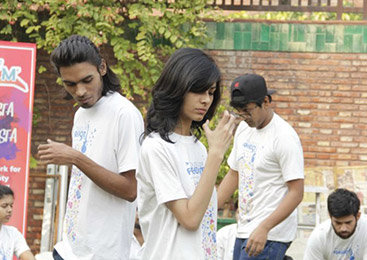
Naatya Raasta Diaries
For someone, who’s had a very little experience in theatre but wants to stick with it for as long as possible, events turning out in their favor might seem like a little magic from the universe. Yeah, well, toning it down a little bit, I would say that I had always sought a connection in theatre, and as I was drifting away from it, things started to fall into place when exactly two months ago, I somehow got to know about a theatre workshop organized by The Yuva Ekta Foundation and went there to attend it. Little did I know was that this workshop will lead to a course of an entirely new experience for me that I would remember for my life.
SOF Naatya Raasta, a platform for aspiring actors to showcase their skills while working for a social cause urged me to be a part of it and right from the auditions to the final performances, each aspect of this process has managed to etch itself and this will stay with me for the longest time possible.
To begin with, a bunch of young adults came together to experience an entirely new domain of theatre under the supervision of Puneeta Roy, which remains to be our lodestar till now and for other performances to come. 13 of us were total strangers to each other and in a span of two months, amidst all the practice sessions, scripting process and the warm-up games we became a team and like true team players, relied on each other at one point or the other.
The cause that we worked on ranged from redefining masculinity to power sharing, breaking stereotyped gender roles and all this while we had to make sure that it’s informative enough for the masses, so that when we perform it out through nukkad naatak format, we deliver a cause which urges people to read between the lines. The entire process helped me a great deal in transcending the outdated social laws and a stereotypical behavior that we project towards things not out of choice but rather, out of stereotypes. Working on third gender problems and sensitizing the masses to it was one of the causes we picked up. The hypocritical nature regarding gender roles is often seen in our society and keeping this in mind, we brought up many daily-life instances which portray how disparities between man and a woman tend to grow as soon as the question of equality surfaces. Doing all this, at some level, I got to know about my own loopholes and started to bring these issues to dining table conversations back home. To my dismay, my parents obviously couldn’t understand the dynamics of feminism or overhyped concept of masculinity but at least I tried bringing this up in my family and as they say, charity always begins at home, I served the purpose well.
Besides the cause and its subsequent effect, what I loved the most in the entire process was the sheer honesty and humility in the people who kept us glued the entire time without making us feel low at any point of time. Imagine a place where you go and meet a bunch of brand new people in your life and you cannot help but remain in a perpetual state of awe with most of them and in the end, you think about it and say, ‘was it really a happy place that I was in?’. this is exactly the same thing I will continue to cherish and be amazed at how brilliantly we all managed to get our things done, where nobody was abused, verbally or otherwise, nobody cried for wrong reasons and we never practically played the typical sadistic part like the ones they play in dramatics society of Delhi University to get things done! Pheww! All went well.
In the end, I would like to conclude by saying that never in my life have I met so many beaming faces, someone’s who’s ready to help you at any given point of time, and someone who has made peace with human idiocy so they will never judge you, someone who loves and is a giant throbbing heart, someone who can be super intelligient like a scientist and still look pretty, someone who changes you for good and I got to see them, meet them, be with them, for a good 2 months. Plus, we also worked for a cause. Our Ladyship Puneeta Roy, without whom we all would never have come up with any performance, let alone the scripting part, made us stick together for good and saw in me and all of us, the potential to do a little extra and little better than the rest who couldn’t be a part of this. We became the Change. We contributed in changing the world, in our own tiny ways.With love. With conviction. With Faith
Till next time, Cheers =)
-Ritu Bhatt is a Delhi University pass out, a passionate blogger and one of the actors in Sounds of Freedom’s ‘Naatya Raasta’ theater group
READ MORE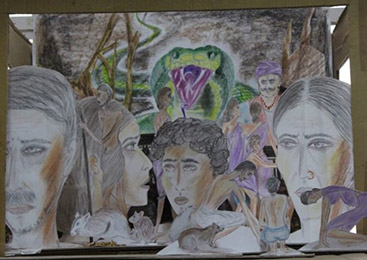
My introduction to Papier Theatre – and how I Survived!
Raju, Matia, Sonu… unforgettable characters spring forth from the pages of Shyamal Kumar Pramanik’s short story “Survival”, to share their gnawing hunger and degrading struggle to survive. Not an unfamiliar “Dalit” story. Yet they come home with me every night.
I have signed up for a Papier Theatre workshop for 3 weeks mid March, not actually being a puppeteer! From making documentaries, corporate films and Television programs for 20 years, I had gone back to my first love Theatre and was enjoying exploring its power as a tool to communicate and empower. At the core of it all was the consuming fire of storytelling, and as I realized, the greater the skill of the teller, the more magical the story.
“Alain Lecucq and Nargis Majd are Master Puppeteers, who will be focusing on the dramaturgy of the story, on the “What”, “Why” and “to Whom” you want to communicate with. You would enjoy it”. Anurupa’s words have me hooked!
I send in my application, get an acceptance and for the next 3 weeks, starting 14th March, I jump into my car at 8am and zip down the highway from Gurgaon, to make it on time for the 9:30 workshops at the Crafts Museum. This means no morning walks or exercise but such is my enthusiasm, that everything else is put on hold for 3 weeks. Of course I will pay the price of excruciating cervical pain once we go back to our “normal” lives, but I am so much richer for the experience!
It is an enchanting 3 weeks of stepping into a fairy tale world of make believe and watching it come alive! Starting with making simple paper stages and stories from personal experiences, we are exposed to some mind boggling videos of shows that Alain has done as well some of the most creative and innovative ones from across the world. I remember crawling back to the workshop space feeling most disheartened and almost embarrassed about what we had presented on the first day. The Bar of Excellence has suddenly gone so high, we have not even made our first baby steps!
Alain and Nargis are amazing as they alternate between being teachers, parents, guides and friends, adding to the warm bonhomie that has developed within the group. Starting with 11 participants, 9 of us complete the course, exploring 4 different stories through completely different formats.
My team mate Binitesh and me choose to work on Pramanik’s story “Survival”and spend the first few days diving deep into the themes and sub themes that the story opens up for us. Out of the 5 to 6 strands that seem to flow through the story, we have to crystallise our thoughts to choose one Central idea that will be our touchstone for all the creatives thereafter.
Wading through the complexities the story throws up for each one of us, we struggle to define that simple connecting thread, little realizing how important this will be, in keeping our entire presentation true to our central theme.
As I put pencil to paper and start allowing the story to flow into the storyboard, it comes alive in a way I have not experienced before – so simply and so quickly. I am Raju, fighting against the bitter cold, to feed and protect my wife and son – Matia and Sonu. It is my mother who has died an excruciating death while my father watches helpless in the famine, and I am determined this will not be the fate of my child.
Bini and me discuss, argue, agree, work together, reflect individually, share our thoughts and arrive at a consensus most times. It is fascinating to see a baby being crafted by two completely different individuals, drawn to a common theme, and to see it evolve from paper sketches into human characters as we draw and colour and fix them to cardboard sliders with “spines” glued to their backs.
Our little wooden stage is built by a carpenter simultaneously and as backdrop after backdrop slides into its slot on our stage, the characters or “paper puppets” glide on to share their tale of desperation and sheer grit to stay alive. At our final presentation at the India International Center, we add the magic of sound effects and focussed lighting and I am told that the effect is quite mesmerising. “Where would we be taking this show from here” is a question I am asked by many members of the audience.
Yes, where indeed would I be taking the show? Bini has gone back to Mumbai to teaching at his Film Institute, but I do have Raju and Matia and Sonu with me, who sit in my office room and look at me questioningly everyday! I owe it to them, to Alain and Nargis, to Ranjana and Anurupa, to our wonderful group who worked together and to Bini and me, to keep them alive and introduce them to all those out there who want to receive them.
Ah, the forest beckons and I promise we shall all walk through it again – soon!
– Puneeta Roy- Managing Trustee, The Yuva Ekta Foundation
READ MORE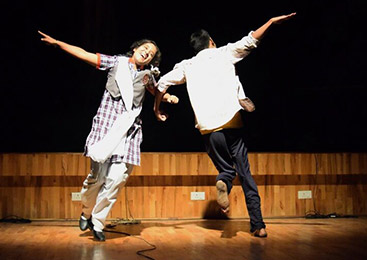
“Only connect!”
“Only connect!” – E.M. Forster
In times when building walls is being noisily celebrated, art silently labours in creating bridges. It is one of the most satisfying labour one can experience. Theatre being the most hybrid form of expression unearths a world of perspectives and possibilities. It thus has the ability to ignite hope and spirit amongst people, come what may.
My journey with The Yuva Ekta Foundation- working on our play “Bargad Ki Chhaon Mein” (In The Shade of the Banyan) – has helped me grow both as a performer as well as an individual. Reflecting on the entire process of collectively creating this production- from stimulating rounds of auditions, the overwhelming visit to Jahangirpuri (of which the stories we attempt to portray), the number of innovative workshops and the consistent rehearsals- I cannot help but share my absolute delight at being challenged on each step!
One might think of oneself as a performer/ individual of a certain measurable capacity. Then of course there’s the typical “scope for improvement” remark that follows one throughout. But never have I “witnessed” the breaking of limits we set on ourselves like I experienced at The Home Away Festival at The National Theatre of Scotland. Our play totally had a life of its own on the day of the performance! The characters came alive on stage like never before. Was it the energy of the space? The audience? The months of hard work everyone had put in? Yes, yes, and yes. But above all, I think, it was because we all actually believed in the infinity of our potential (both of our play and as individuals) that it became the highlight of the entire journey.
Meeting theatre enthusiasts from across the globe, sharing performances and practices, exploring the breathtaking beauty of landscapes miles and miles away, and bringing back home new friendships and such warm memories is something I will cherish forever.
A big Thank you to our dear director Puneeta Roy, The Yuva Ekta Foundation, Dilip sir and Gilles, Simon Sharkey, The National Theatre of Scotland, and all my fellow cast members of “Bargad Ki Chhaon Mein”.
-Harmanpreet Kaur plays the character ‘Anju’ in the play ‘Bargad Ki Chhaon Mein’ that was showcased at National Theatre of Scotland’s Home Away Festival in Glasgow, Scotland.
READ MORE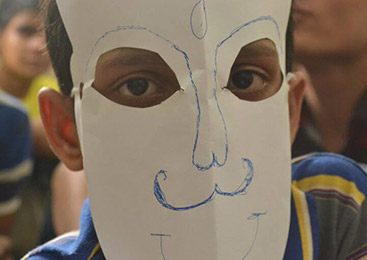
In their minds, Through their eyes!
When I first met Veeru ( name changed) at the de-addiction centre for juvenile delinquents in Sewa Kutir- SPYM Sahyog, I was struck by his concentration level and his love for colours. Thoroughly enjoying the vibrancy of colours while painting match boxes, he started telling me about his family and lifestyle. Veeru’s father was an alcoholic and he passed away when he was very young. His mother got married to someone else and left him.
“I was in dire need of money. Hence I had to do what I did”, says Veeru.
The need for survival is the biggest need that drives any species. Faced with a choice between survival and landing up in the delinquent centre, what else could a fifteen year old Veeru have done?
Eighteen year old Nawas ( name changed) has a happy family of mother, father and siblings at home. He was studying in class ten before coming to the centre and his mother wanted him to be a lawyer.
“My friends told me it was cigarette. I did not know what was inside the roll. When I started enjoying it, I needed more of it”, says Nawas.
Psychologists suggest that late teens are an age when there are extensive hormonal changes in boys and girls. There is a need for thrill and excitement. Such is the age when the activities of the peer group always appeal more than those of elders or other family members. When this peer pressure leads to drug abuse, there begins a vicious cycle. Drug consumption leads to a need for more drugs and this leads to illegal activities to obtain the means to get more drugs. In the process, the teenager might end up selling drugs to other teenagers.
Kamal ( name changed) is eighteen years old and he lives with parents too. Enthusiastic and full of life, he aspires to work very hard once he goes out.
“My girlfriend had left me. Drugs gave me a lot of comfort”, says Kamal.
We live in a society and culture where there is an obsession with finding ‘love’. The movies we watch, the songs we listen to and the books we read, all seem to reinforce this belief in a need for a partner. The need becomes all the more strong when we see our friends indulging in ‘love’. In such a situation, when a relationship fails, there is almost a sense of guilt and shame and also an urgency to prove one’s heroism. If not a relationship, then perhaps there are other ways to fit in to the peer group.
The dazzling eyes of twelve year old Raam(name changed) had caught my attention the very first day that I had stepped into the centre. His agility and chirpiness had literally won my heart. Experimentation, peer pressure, these are traits associated with boys and girls in their mid teens. What could have led a boy who has not even stepped into his teens to substance abuse? It is possible that we are exposing our kids to too much television and media influence. Research suggests that children are most prone to being affected by what they see on the television screen. It is also possible that there is an excessive companionship and dependency on older boys in the peer group who become role models for the younger ones.
Delinquency is not just a social problem; it is the root of a much bigger social problem. Sigmund Freud’s psychoanalytic theory suggests that an individual’s personality is mostly established at the stage of early childhood. Early experiences have a large role to play in the development of personality and continue to affect the individual’s behaviour in later years. It is essential that children go through a healthy development during the early years of their lives. The rise in energy levels that takes place during the adolescent years should be directed towards productive activities. Keeping them engaged in art, music, dance, drama, sports and so on, gives them a proper outlet for the aggression within, as well as helps in their personality development. Furthermore, this aggression needs to be kept in control through parental check and disciplinary measures. Most importantly, children need to be given an ‘I can make a difference’ boost. If they are constantly reminded that their actions will make a difference to society then they will be more prone to indulge in activities which are beneficial to them.
However, the biggest problem arises when children do not have the means to ensure that the above mentioned suggestions are enforced. Poverty or absence of parents and teachers as role models is the bigger problems that lead to delinquency since they are extremely difficult to solve. In such a situation, it is imperative that the state and society steps in to ensure that the children are not left to rot. After all, the kids are the responsibility of the society as a whole and their actions will affect the society as a whole too. It is our responsibility to make sure that every Veeru, Nawas, Kamal or Raam grows up to be an ideal role model for generations to come.
– Adrija Roychowdhury is a Masters student studying History from Delhi University. With a keen interest in theatre, adventure and human stories; she aspires to become a journalist in the future. She is currently, also volunteering at the Foundation to write about different narratives of human motivation, social justice and human rights.
READ MORE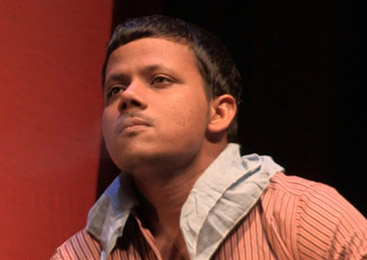
Home/Away Diaries
“बरगद की छांव”, मुझे इस इसकी छाओं में आने का मौका तब मिला जब मैं पहली बार ऑडिशन देने गया,पहले राउंड ऑडिशन के बाद जब मुझे राजन के करैक्टर का ऑडिशन करने के लिए बोला गया तो मैं सोचने लगा की ये कैरेक्टर तो बहोत बेहतरीन है, कई सारे एक्टर्स आये थे ऑडिशन के लिए और मैं इसे करना चाहता था, तो ऑडिशन भी हुआ और मुझे ये करैक्टर करने का मौका भी मिला। फिर 29 जून को हम लोगों को जहांगीर पूरी c ब्लॉक में बुलाया गया ताकि सारे एक्टर्स उस माहौल को समझ पाएं जिस तरह के एरिया की ये कहानी है,और जिस तरह के करैक्टर हम सब करने वाले थे, मुझे इस चीज ने बहोत हेल्प की राजन के करैक्टर को बनाने में। इसी दिन पूरी टीम से मुलाक़ात भी हुई, फिर बरगद की छाओं में की कहानी को जिवंत करने की कोशिश शुरू हुई, और इस प्लेय को बनाते बनाते कुछ अंजान लोग एक परिवार में तब्दील हो गए,और देखते ही देखते 9 सितम्बर यानि वो दिन आ गया जब हमें अपना पहला शो जुविनाइल होम किंग्सवे कैंप में करना था, यहाँ शो करने का अनुभव बहोत ही बेहतरीन रहा, वहां के बच्चे राजन के कैरेक्टर से ज़्यादा कनेक्ट कर पा रहे थे क्योंकि राजन उनमें से ही एक था, उस दिन राजन को जी कर एक एक्टर के रूप में मुझे बहोत मज़ा आया, राजन के कैरेक्टर को करते हुए मुझे और गहराई से ये समझ आया की कई बार गलत संगत, गलत डिसीजन, और कई बार बिना गलती के भी बच्चों को बहोत बड़ी कीमत चुकानी पड़ती है।
16 सितम्बर को हमने वसंत वैली में शो किया, जो की एक इनडोर ऑडिटोरियम में हुआ यहाँ प्लेय का करने का अनुवभ भी अलग था क्योंकि की यहाँ हमारी ऑडियंस अलग थी ,जगह अलग थी।
स्कॉटलैंड
2014 में युवा एकता के साथ ही मैं शून्य से शिखर नाम का प्लेय करने आया था, और 2016 में बरगद की छाओं में।
यहाँ कई सारे ग्रुप्स आये हुए थे उनकी वर्कशॉप अटेंड की और उनके शो देखे, ये जो एक्सपीरिएंस मुझे यहाँ मिला उसको शब्दों में बयान करना मुश्किल है,किसी भी वर्कशॉप में मैं अंजान लोगों से बड़ी आसानी से कनेक्ट हो जाता था जैसे उनको बहोत पहले से जनता हूँ, मेरे ख्याल से ये ही थिएटर का पॉवर है।
9 अक्टूबर जिसका हम सबको बहोत इंतज़ार था वो दिन भी आ ही गया, ये प्लेय इसी दिन के लिए तैयार किया गया था, शो के दौरान मैंने महसूस किया कि सब लोग एक्टिंग नहीं कर रहे थे सब के सब उन किरदारों को जी रहे थे,उस दिन कुछ मैजिक सा हुआ था, सबने बहोत उम्दा काम किया था, शो के बाद लोगो से बात हुई लोग पर्सनली आ कर स्टोरी के बारे में, किरदारों के बारे में, परफॉरमेंस के बारे में बात कर रहे थे, इससे मुझे ये समझ आया की लोग बरगद की छांव में प्लेय से कनेक्ट हो पाए थे, इस बात का क्रेडिट मेरे हिसाब से सबसे ज़्यादा हमारे शो की डायरेक्टर पुनीता रॉय मैम को जाता है, जिन्होंने इतनी रियल और बेहतरीन स्टोरी लिखी और साथ ही साथ सारे एक्टर्स को पूरा मौका दिया अपने किरदारों के साथ जस्टिस करने का । और फिर क्रेडिड जाता है हमारी पूरी टीम को,जिन्होंने इस शो को बनाने के लिए बहोत मेहनत की।
मुझे भी इस प्लेय के दौरान अपने किरदार राजन को बनाने के लिए बहोत काम करने का मौका मिला,मैं कई दिनों से कुछ ऐसा काम करना चाहता था, मैं ग्लास्गो ट्रिप के दौरान अपनी टीम को और गहराई से जान पाया, मैंने ये भी महसूस किया कि जब आपके आस पास पॉजिटिव लोग होते हैं तो हम भी पॉजिटिव होते चले जाते हैं और हमारा काम भी बेहतर होता चला जाता है, मेरी तो पूरी टीम ही पॉजिटिव लोगो से भरी हुई है, मैं अपनी पूरी टीम को थैंक यू कहना चाहता हूँ, मैं National Theater Of Scotland को भी थैंक यू कहना चाहता हूँ जिन्होंने इतना प्यारा, इतना शानदार Home Away फेस्टिवल ऑर्गनाइज किया।
इस ट्रिप के दौरान मैं घुमा भी और नेचर को थोड़ा और जाना भी, नई नई जगह और लोगो को देख कर लगा की दुनिया में बहोत कुछ है एक्स्प्लोर करने को।
ओवरऑल मुझे एक ऐसा एक्सपीरियंस मिला जो मेरे लिए बहोत अनमोल है, ये मुझे हमेशा याद रहेगा, इस शो का हिस्सा बन कर मैं बहोत लकी फील कर रहा ह और आगे हमे और भी शो करने हैं उसके लिए भी मैं उस्सहित हूँ, इसके लिए युवा एकता फाउंडेशन का जितना भी थैंक किया जाये काम होगा।
Thank you The Yuva Ekta Foundation, Puneeta Maam, Dilip Sir, Mrinalini ma’am and Gilles sir for the opportunity.
-Pankaj Gupta plays the character of ‘Rajan’ in ‘Bargad ki Chhaon Mein’, the play that was performed in Glasgow, Scotland as part of Home/Away Festival.
READ MORE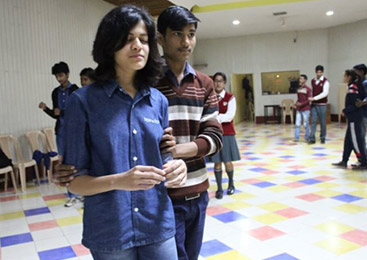
Finding Me- Jaipur Diaries
The finding me workshop has been one of the most amazing things that I have ever experienced. This has truly changed the way I look at life drastically.
Ten days ago, when I entered the workshop, I did not believe in the fact that we, the youth, had the power of affecting and influencing people and encouraging them to be the better people that they are. This workshop has made me aware that people of my age face all kinds of problems. That mine are not the most important. That I am not the only one. It has taught me that everyone in this world, no matter what their caste, creed, color, shape, size; are the same. That we all think alike and experience the same things.
When we set out to spread this message to the youth, the feeling was wonderful. I realized that helping someone else overcome their flaws or plain accepting themselves and others as they are, is the best thing one can do.
I have realized that we, the youth, can make a great impact on the world, to make it a better place for you and for me.
– Simran Jain from Jayshree Periwal High School was one of the participants of the Youth Outreach workshop at Jaipur Literature Festival 2016
READ MORE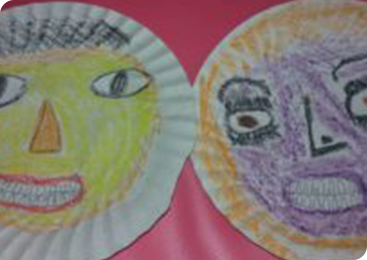
Dreams and Transformations
Tucked away in North Delhi’s Kingsway Camp is the Seva Kutir complex that houses (among other spaces) an observation home for juvenile’s under trial as well as a detoxification centre for juvenile addicts. The complex is as green and clean as it is militarized with high walls, flood lights, barbed wire, broken glass atop the walls and unforgivingly reinforced metal doors that require Herculean strength to budge. It is hard to enter a space like the observation home without preconceived notions about the incarcerated minors who are temporarily staying there. However, the children effortlessly destroy each and every such notion in a matter of minutes.
Avik Roy and I began our ‘Theatre Workshop’ for the children in the observation home on the 4th of September 2014. Our plan was to have a fluid plan. We wanted to gradually get to know some of the boys as well assess how exactly to go about introducing these young accused boys to the world of theatre. My biggest fear while initiating this process was that the boys would probably scoff at a theatre workshop being held in a halfway house where they do not expect to be lodged for more than a few weeks at most. Majority of the boys expect to be out in a matter of days. We decided that fast paced and energetic games would be the best way to grab their attention and luckily we weren’t entirely wrong. With the legendary ‘Dog and the Bone’ we began a relationship that altered our worldview forever. It is difficult to precisely document all that we felt and observed in the daily 2 hours we spent (and continue to spend) with the boys. Instead, it would be easier to describe some of the things we encountered that were radically different from the expectations that we harboured upon entering the observation home.
Most of our expectations of jail are informed by a great deal of popular culture representation that is fed to us on television and film. The reality of Aadharshila is very different. The children are not cooped into cells but instead have large shared dorms along with well maintained sports fields and courtyards. It is of extreme importance that we remember at all times that these children are not convicts but simply accused of crimes. Many of them are no different from the way we were when we were kids. Even though most of them are school dropouts, their levels of awareness are no less than any child exposed to the same media.
The first few days of the workshop were haphazard because the children (and the two of us) remained entirely unsure about what we were doing. The boys were hesitant and were not particularly interested in the introspective aspects of the games. Some of them would stay for the games they enjoyed and then utilize extremely creative excuses to vamoose at the very point something serious or sombre was being discussed. By day 4 our heads began to droop, two boys broke into a fight and things started were looking stagnant and progress seemed almost impossible. We then realized that we needed to spice things up and start getting the kids to get a sense of acting, character, narrative arc and other simple concepts of theatre. We finally settled on the most trusted group, who showed an initiative to be a part of this process. Some started to get excited at the prospect of performing a play.
We would have preferred if the play had been scripted and written by the children based on their own stories. We had gotten them to share, draw and write about themselves but it remained impossible to get them to create a fiction work, and so we had to take the scripting upon ourselves. The boys thoroughly enjoyed portraying the story of a poor boy who falls into drug addiction and subsequent petty crime which lands him in jail. The performance was cathartic in a way we least expected. The boys had their fellow inmates roaring with laughter and completely immersed in the play. They cheered the boys playing drug addicts but suddenly became pensive and quiet when our young protagonist spoke about his dreams and aspirations. The play ended with each boy telling the audience their name, and what they will be when they return to the world outside.
There has been so much injustice, anger, resentment and frustration that these boys are often lost about how to channelize their emotions. They blame the system, they blame poverty and often just simply do not want to come to terms with their own faults. Our aim was to instill hope and a sense of achievement that could help these teenagers break out of the trap of blaming circumstances and taking control of their own destiny, even if against the odds. It was not just the play, but the entire experience of getting to know these boys that was transformative for all of us involved.
– Shaman Marya is a Law graduate from Delhi University, deeply interested in film making, who has been associated with Yuva Ekta earlier during the 2008 Summer Programme and is now a volunteer with us.
READ MORE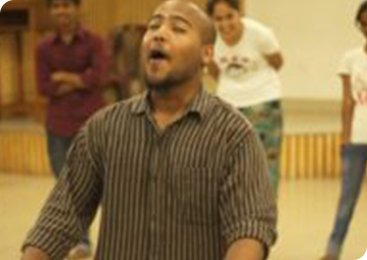
Yuva Ekta 2011-Dainiks Volunteer Diary
April 29, 2014
A year has passed by since the first time I bonded with various people from amazingly differing horizons. Having so many people who are brimming with ideas in one room just makes me go, “Whoa”! I find myself sitting in that same room with gazillions of thoughts that have already taken shape and those which are just ready to burst out.
Vaguely enough, I find myself not on time almost every day. Yet, my un-punctual character is greeted with smiles that peep through to show delight in its full glory. Else, I’m made to do push-ups that just get me even more pumping for the 3 hours that we spend together. The same (or some other ritual) is inflicted on anyone who’s late. Yet, it ends up making that very person sense things with a whole new dimension and a colorful perspective.
So lost in the midst of wonderful people, I find it hard to keep track of my experiences in their chronological order. Each moment is so exciting and stimulating that one gets lost in it like a man would in a universe filled with shiny stars. And then there are those extra special moments when an otherwise quiet person bursts out with joy on experiencing their new found treasure.
Some do get “tired” in the warm up sessions, but all of that fades away once we start cracking jokes at each other and begin our day. From loud “HA’s” to mind numbing physical exercises, we begin with little bodily and mental modifications every morning. These prep us for the whacky activities that hit us out of the blue. These are followed by more exercises targeted towards new muscles that we discover everyday (some are found inside my highly bald head as well). Sometimes it seems as if flexing my goatee muscles would be easier. Then we “break” off for a sip and a bite and wander around to reboot our complex personal utilities.
Me yelling “GOLA BANAO!” is a common site. After each one of us is back in the “gola”, we break off into groups trying to make tiny scenes of everyday life by pooling in our ideas. Ah! It would’ve been so tranquil if it were that simple! Numbers, losses of consonants, strange situations are only the beginning. Making us think harder, some awesomely beautiful ideas crawl out of nowhere. To state a few, we did sing “Ek, Do, Teen! Char, Paanch, Chey, Saath, Aath, Naw, Dus, Gyara! Bara, Tera!” in a disco scene, and then we broke out in thunderous laughter trying to articulate sentences without their consonants, like “U O-Ot U-Ar Oh!”
Always stumbling upon new ways to entertain each other, we end up learning bucket loads of new things. Three hours fly by as if it were only a minute, a room with tons of commotion falls silent within that minute and “chappals” keep disappearing and turning up at weird places (pranks carefully planned out by a mastermind who is still on the run). And then the long wait for a new day begins…
Danik Ghosh aka Boomba is a Bluebells School International graduate, who was part of the Yuva Ekta Workshops in Summer, 2011.
READ MORE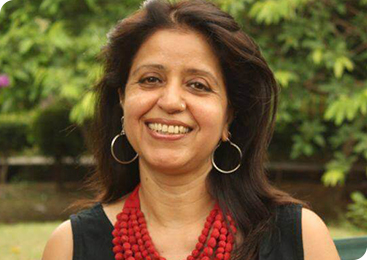
Director’s Note
“Didi (sister), will you bring me a Tulsi (basil) plant on your next visit? The Tulsi is sacred; I will put it in my mandir (temple).”
This is the summer of 2009. We are at the Observation Home for Boys at Kingsway Camp, Delhi, surrounded by 25 juvenile offenders who have come to attend my Remedial Drama workshop. We are discussing dreams and aspirations and as the boys share their stories, Rahul asks me for a basil plant.
Robbery, Murder, Rape, Extortion – their crimes are brutal. Each boy feels falsely implicated, believes that the system is working against him. Most come from dysfunctional families, have no Role Models, no Heroes who can inspire them to find a way out of the horrific entanglement of drugs, alcohol and crime.
Our challenge is to make them aware of their choices in every situation, choices that will empower rather than debilitate them. We begin using the tools of Theatre and Expressive Arts and every few months a new intervention convinces me of the possibilities of a new start to these young lives.
This is the space from where our play “Bargad Ki Chhaon Mein” is born. Questioning the ever-widening chasm between the marginalized and the privileged, demanding accountability from a society that aspires more for Mercs and Mobiles rather than a qualitative education for all.
We have begun to work at a resettlement slum close by where many juveniles live and as I try to understand complex migration issues, I sometimes falter, grow weary. And then I remember my first conversation with Rahul, seven years ago.
“Rahul, tell me then, where does your God reside?” “In the temple that is within my heart!” he answers. “And when you pick up a knife to kill, where does your God go?” I ask. “Didi, the doors of my temple were open long before and my God has left me. I am still waiting for him to return!”
The Banyan is a healing tree, with a loving, protective aura that embraces all with its grace. Our play attempts to re-create this magical, expansive space in which everyone is welcome.
– Puneeta Roy, Managing Trustee – The Yuva Ekta Foundation, is Writer and Director for the play- ‘Bargad Ki Chhaon Mein- In the shade of the Banyan’ which will be travelling to Glasgow, Scotland in early October as part of National Theatre of Scotland’s project HOME AWAY.
READ MORE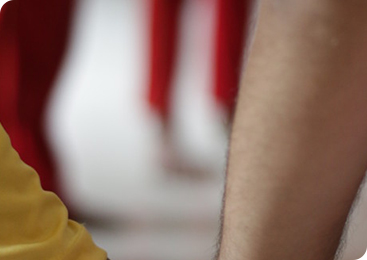
‘FREEDOM TO DREAM’ @ AADHARSHILA HOME
“I want to complete my education and become a big man one day” – Participant, Aadharshila Home
“I have always wanted to help people and with my work, I’ve managed to fulfill that dream” – Member, Child Welfare Committee
Be it the young, or the younger, everyone dreams. Our dreams connect us to our innocence and light, that makes us one with our being.
The Foundation, on August 25, 2017, conducted a Capacity Building workshop at the Delhi Judicial Academy for members of Child Welfare Committee, Juvenile Justice Board and organisations that work in the sphere of Juvenile Law. A small and engaging performance by the boys from the Adharshila Observation Home titled ‘Khwaabon ke Par’, was followed by an Art activity that engaged all stakeholders on one platform and share their dreams with each other.
A magical afternoon turned surreal because of the interactions that helped everyone understand and empathize with one another. It also promised to bring back the same innocence within all participants that helped them remember their lifelong dreams and aspirations. As our country completes 70 glorious years of its independence, we hope to continue our work with ‘Youth at Risk’ and find ways to connect the young ones with their light, their humility and their passion.
We would thank Gauri Saxena, Mona Sharma and Pankaj Gupta for making this event possible. We would also like to thank our guest facilitators Bani Malhotra, Tavishi Krishna and Ankita Dasgupta for their contribution towards the workshops!
Picture Credits- Aarushi
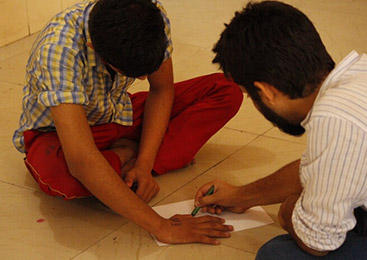
The Compassionate Gaze
Last year (2016) we began our journey of moving deeper within urban slums and communities in Delhi. Our work with ‘Juveniles in Conflict with Law’ had taken us to a different spectrum of urban life in the city. But it is always important to go back to places that have equipped us to take the next step in the field of Social Arts.
The Adharshila Observation Home for Boys has been that space. It is an area where urbanisation, migration and the law interact at complex levels. The recently amended ‘Juvenile Justice Act (Care and Protection Act) 2015’ has changed the discourse on crime and punishment for years to come. The merits and demerits of the act continue to be heavily debated.
As one of the tenets of punishment, we strongly believe in the power of reformation and the ability of legal institutions to engender change. The Observation Home in Kingsway Camp has been one such institution where this transformation is being realized. All our visits to the home so far have increaseed faith in our own work and the role Expressive Arts can play in the process of self-learning and self-growth.
This experience has been incredibly satisfying. Although we have been working in the Observation Home for the better part of the decade, the connection with the children this time is special. We started working with a group of 15 inmates in the first week of May (2017) towards a workshop that will culminate in a performance at the Delhi Judicial Academy. We are exploring the idea of ‘Dreams, Delinquency and Destitution’ in the context of ‘Youth at Risk’. The time spent so far has also revealed a lot that needs to go in working towards the issue of mental health and diverting public opinion towards a more compassionate gaze.
We started our workshops by introducing the children to basic theatre warm-ups and creative exercises before slowly moving on to ‘childhood dreams and aspirations’. Once we got to this playful core, the task ahead become easier and smoother. Participants shared their stories, circumstances, future goals, inhibitions and restrictions that have shaped their lives today. We also explored enabling oneself to overcome these barriers and look for respect where it matters the most: to the Self.
This connection of course, comes with its own set of challenges and precautions. We do not believe in any hierarchy and genuinely consider this process to be a mutual one.
Expressive Arts is a tool that allows one to go beyond the defined realm of conversation and thought and make room for a deeper probe into issues of identity formation that the youth struggle with today.
Working at the Home only strengthens our resolve in the core vision of the Foundation, that of equity and social justice. We do hope that this time spent can only pave way for more work in the future that is centered on the idea of healing and empowerment.
–Rijul Kataria works as a Research coordinator with The Yuva Ekta Foundation.
READ MORE
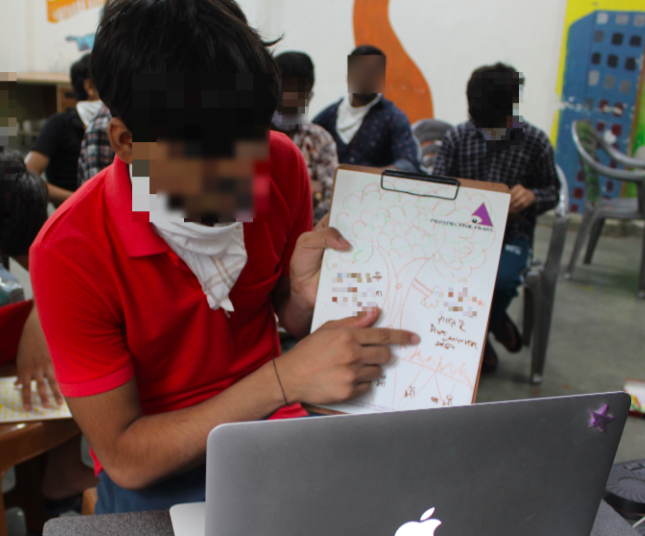
New Beginnings, New Challenges: Threads of Humanity
The year 2021 saw us begin our work at Majnu ka Tila (project site) with new gusto. 2020 had been a tricky year for the Threads of Humanity program. Our physical visits to the Home had stopped earlier in the year as a result of the lockdown. To get the on-going interventions back up was a challenge. We tirelessly coordinated with the staff at the Home to start the online workshop process. While our effort never lacked intent, we were always dismayed by factors beyond our control, mostly pertaining to internet connectivity (read more about it here). As a result, therefore, our message and the workshop activity never effectively got to the boys. As soon as the lockdown lifted, we shifted to a part-on-ground, part-online model. Two of our facilitators were always present at the project site following all rules of social distancing and sanitisation, even as one of our facilitators connected with the boys online. The workshops were planned much in advance so that even when the connection was patchy, the workshop never stalled. Simultaneously, our team was also connecting with the boys outside, released on early bail/parole, owing to social distancing norms at the project site. We were constantly in touch with them, providing a safe space for them to express themselves in these uncertain times.
In the last year, we ran workshops to specifically address the growing emotional uncertainty around Covid, and the resultant impact on the boys’ emotional health. Meanwhile, we also waited for our grant from the Azim Premji Philanthropic Initiatives (APPI) to come through. Our wait and work to get the grant finally paid off as we received confirmation in December 2020 about the approval of our grant. Our team had been tirelessly working with the APPI team for over a year, to get approval for this grant. We wanted to start a ‘Comprehensive Program for the Rehabilitation of Young Offenders’, building on our previous research project (read more about it here) and address areas that we earlier weren’t able to. Our plans got delayed by a year because of Covid. We even adapted our work proposal submitted to APPI, adjusting to the emotional demands and logistics that changed during the pandemic. In our proposed three-year program to APPI, the first year would now go in trying to find rhythm and grove of the workshops as we know. We also introduced a new element to the program wherein we keep in regular touch with the boys who have been released on early bail/parole due to Covid protocols, following on from the practice we began during the pandemic itself. A comprehensive rehabilitation would therefore mean to work with the boys extensively when they’re inside the facility and keep in constant touch when they are released. The sheer joy of our program being accepted and the grant coming through was what led to an increase in our gusto and enthusiasm.
We started our program in the first week of January 2021, by first recognizing our sample group and asking for volunteers to participate in the workshop process. After that, we went on to conduct standardized psychological assessments on our participants, in order to enable ourselves to adjudge the impact of the workshop process. The chosen ‘Mental Health Battery (MHB)’ is a comprehensive scale that covers several parameters that we’ll be addressing this year. Complimentarily, we also selected samples for Case Studies and involved the staff’s feedback at the home in our data collection process. The idea to triangulate our information is to make our research design exhaustive and expansive.
We began the workshops in the second week of January with a group of 30 boys. Some boys had been released/transferred even before the workshops began, our scientific enquiry had to be repeated with the new arrivals. The data collection process continued well into February, as the group size kept fluctuating. As mentioned earlier, the stay-time at the Home is now sporadic, as new cases are being monitored faster to de-clutter the Home.
A month now into the program, we have a relatively stable group and are proceeding to conclude the first part of the first module in the workshop process. Our three-year program is divided into six modules and each module is divided into six months and therefore we will end up working with a lot more participants inside the facility each year. Each module has also been divided into various parts, depending on the emotional capability we’re trying to address.
The journey has just begun. There is excitement and nervousness at the same time. We have immense gratitude for the opportunity to be able to go on-ground and do what we love. At the same time, there’s always the uncertainty surrounding the times we’re in. Our relationship with the Home is growing deeper with each passing week, and we hope to continue this fruitful association for times to come.
READ MORE